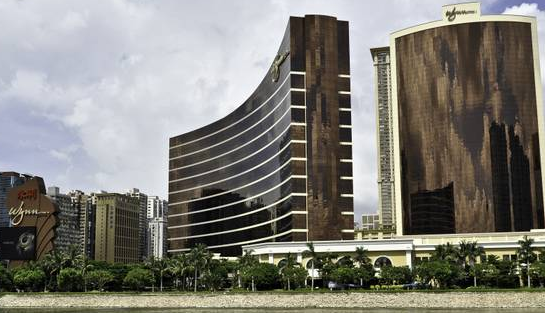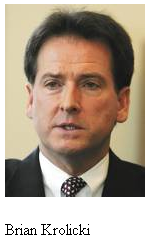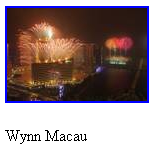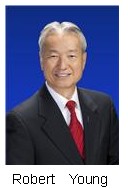Relationship Between Las Vegas, China Runs Deep
9/27/2011 5:00:47 PM Joyc.biz
From possible investment in green energy or high-speed rail to the color of the carpet at Encore, China’s influence is everywhere in Las Vegas.

In the early 1860s, in the newly named territory of Nevada, settlers had a problem. Gold and silver had just been discovered in the mountains, but there was no easy way to transport it out, or to get workers from the California-based mining industry in. The solution would come from China.
Chinese immigrants made up 90 percent of the workforce that built the Central-Pacific Railroad, which lifted early Nevada from intermountain oblivion by connecting it to the rest of the country. In the 20 years after construction commenced, the state’s population grew tenfold.
Now, 150 years later, Nevada is once again turning to China again to pull its economy out of a protracted recession, which economists predict, absent some prodding, could hobble the state for the next two decades.
This time, it’s going to take more than a railroad (though high-speed rail is one piece of the hoped-for fix). Nevada’s economic situation will require a long-term solution encompassing mines, casinos, a fledgling export market and energy.
Nevada, we keep hearing from lawmakers and lobbyists, has a lot of potential in all those areas. But China has the one thing neither Nevada nor the US government has to develop that potential: Cash.
After years of growth in America’s appetite for Chinese imports, China holds the biggest share of US government debt among foreign entities, about $1.2 trillion. In recent months, the tide has been shifting. Although China still sends out more than it brings in, its demand for imports is surging—as much as 30 percent in one month this summer—and some US states are seeing opportunities in China’s new willingness to spend.
For Nevada, China’s growing consumer culture is helping keep the state afloat in the short term by sustaining gaming and tourism. In the long term, state officials are counting on China’s emerging entrepreneurship to provide investment for Nevada to modernize and diversify its economy.
But just as it was a century and a half ago, the road to a prosperous partnership is paved with potential political pitfalls.
Chinese immigrants who came to Nevada in the 1860s were lured by the promise of steady employment and a territorial charter that was relatively friendly to foreigners, allowing them to own land and mining claims. But they endured discriminatory pay and fierce racism.
Once the railroad-building boom was over, many left. Chinese made up almost nine percent of Nevada’s population in 1880, but by 1950 their numbers dwindled to 241. And although the local Chinese community is enjoying another surge these days, it still less than one percent of the population.
Today, anti-China sentiment is driven more by economic realities than racism, but the attitude still stems from a perceived threat: That cooperation with the Chinese will lead to the economic undoing of the United States. Outsourcing—causing the American economy to hemorrhage more jobs—is the chief fear, and one that politicians of all stripes have stoked.
There are other barriers too. China has not been responsive to American demands to improve its record on human rights, especially in Tibet. Piracy is a huge problem in parts of China, especially for high-tech businesses that rely on patents and respect for intellectual property. China also exploits its trade advantage through currency manipulation to keep Chinese products cheap. Democrats are now advocating tariffs, and Republicans are calling for China to be eliminated from global free trade zones.
It creates a dilemma for the Silver State and its economy: Should we back off until the political dust clears, or grasp a fleeting economic opportunity in an effort to get on the leading edge of Chinese investment. In reality, the state may not have many other options. Nevada’s critical casinos-and-tourism sector has lagged the country in recovering from the Great Recession. Meanwhile, a fiscal crisis in Washington means federal funding for new economic ventures, especially in renewable energy, could dry up in a matter of weeks. That’s incentive to cross the political picket line: The faster Nevada gets ahead of the curve in building an alliance with China, the better the state’s prospects of attracting investment. Nevada, after all, has the advantage of a long-established relationship with China, born in betting rooms more than a decade ago.
 “If we can capture some of the economic engine that is Asia today, and largely China, Nevada benefits marvelously,” said Lt. Gov. Brian Krolicki in an interview last week, after returning from an official two-week trip to China. “It has really been one of the few bright spots in a very difficult economic environment in Nevada in the past several years.”
“If we can capture some of the economic engine that is Asia today, and largely China, Nevada benefits marvelously,” said Lt. Gov. Brian Krolicki in an interview last week, after returning from an official two-week trip to China. “It has really been one of the few bright spots in a very difficult economic environment in Nevada in the past several years.”
...
Take a twirl around the two-and-a-half year old Encore and it’s hard to escape the Asian influence. The rugs, chandeliers and wall decorations are red, the color of good luck in China. Giant peacocks—the mascot of the Ming dynasty’s divine sovereigns—guard the entrance to a room on the main casino floor dedicated to baccarat, the favored game of Chinese high rollers. (It’s now the Strip casinos’ fastest-growing revenue stream.) The flagship restaurant of the Wynn/Encore properties—Red 8, the color and number of  Chinese good fortune—holds to the theme. And then there’s the owner. This spring, Steve Wynn, who’s studying Mandarin, boldly declared his company was a “Chinese company” at its annual convention, held for the first time in Macau.
Chinese good fortune—holds to the theme. And then there’s the owner. This spring, Steve Wynn, who’s studying Mandarin, boldly declared his company was a “Chinese company” at its annual convention, held for the first time in Macau.
The muggy gaming Mecca by the South China Sea elicits varied emotions in Las Vegas—from jealousy to gratitude. For casino owners such as Wynn though, it’s a lifeline. In the second quarter, almost 72 percent of the company’s $1.36 billion in revenue came from Macau. Once taxes are factored in, the profit is nowhere near that dramatic, but the raw numbers show where gamblers are spending the most money.
It’s the same story at Las Vegas’ other two casino giants. More than half of Las Vegas Sands’ $2.35 billion in second-quarter revenue was produced in Macau, and for MGM Resorts International, second-quarter earnings in China nearly quintupled in a year. Casinos in Las Vegas, by comparison, have only begun to show small improvements since the recession.
“The three major Nevada companies’ holdings in Macau have become dominant assets in terms of their contributions to corporate performance,” said Bill Eadington, who runs the University of Nevada, Reno, Institute for the Study of Gambling and Commercial Gaming. But as startling as it may be to see Las Vegas outpaced in its trademark industry—first by Macau and now by Singapore—experts caution that it’s not a horse race with winners and losers. “There’s a very strong symbiotic relationship between Macau and Las Vegas,” Eadington said. “I don’t think Macau directly competes against Las Vegas at all.”
Macau broke onto the international gaming scene after returning to the control of mainland China in 1999 after several centuries as a Portuguese protectorate. A similar transfer had taken place in Hong Kong, a former British colony, in 1997. It was a time of a rampant economic crisis across Asia that slowed China’s growth. “That’s what really triggered the process, to start to look at economic diversification,” said Jonathan Galaviz, an economic analyst for the casino industry who heads the University of Nevada campus in Singapore. “This sleepy backwater called Macau, which nobody was really paying attention to, was in the process of liberalizing its gaming industry. But the end was to have tourism, not just casino revenue.”
With companies raking in the revenue in Macau, and moving on to other parts of Asia, there’s little incentive to bring profits back to Las Vegas. But the process, local tourism officials agree, has helped spread the popularity of casino tourism across Asia, sowing the seeds of wanderlust that eventually lead back to Las Vegas.
“Since the influx of Las Vegas corporations investing in Macau, we’ve seen a steady increase in the number of Chinese visitors, more than ever before,” said Jesse Davis, director of international communications for the Las Vegas Convention and Visitors Authority. “China has now become our No. 5 source of overseas travelers,” lagging only about 12,000 visitors behind No. 4-placed France but growing much faster. The current annual count of almost 150,000 Chinese visitors to Las Vegas represents a 38.3 percent jump over the last year.
No one expects Las Vegas casinos to triple or quadruple revenue as a result of Chinese visitation. But Nevada’s official Chinese investment advocates stress the international casino connections yield dividends outside the gaming rooms.
 “Las Vegas is the No. 1 trade show destination in the world,” said Julia Zhang, who works for the Nevada Commission on Economic Development in Beijing. “But if they come to the US for a trade show, they’re not here only for the trade show. They also want to meet the local companies and have face-to-face meetings to build other cooperation.”
“Las Vegas is the No. 1 trade show destination in the world,” said Julia Zhang, who works for the Nevada Commission on Economic Development in Beijing. “But if they come to the US for a trade show, they’re not here only for the trade show. They also want to meet the local companies and have face-to-face meetings to build other cooperation.”
“Foreign direct investment, that’s what we’re going after,” said Robert Young, past president of the Las Vegas Asian American Chamber of Commerce  and one of three attaches commissioned by the state to promote Nevada deals abroad. “This city, this state and its practices are so pro-business that if you can bring enough people, they’ll invest.”
and one of three attaches commissioned by the state to promote Nevada deals abroad. “This city, this state and its practices are so pro-business that if you can bring enough people, they’ll invest.”
...
In the southern tip of the Silver State, a tract of land is aptly named “Southland.” It’s just a few minutes’ drive from Laughlin and the Colorado River—but standing in the middle of the area, you wouldn’t guess it. It’s dotted with short, stubby brush. A highway runs through it. That’s about it. But out of this barren desert, a Chinese energy company plans to give rise to the United States’ first glittering eco-city: The next-century heir to Andrew Carnegie’s oil towns, made for a renewable-energy era.
The goal is to turn the area into a part-business, part-energy plant, part-residential, self-sustaining city. At the heart of the 9,000-acre, $4 billion plan is a solar panel factory. “We don’t manufacture much in Nevada. But we’re going to manufacture solar panels here and we’ll export them and it’s going to breathe life into an area that’s struggling desperately,” said Steve Sisolak, the Clark County commissioner who’s been working with the project’s Chinese backer, ENN Group, whose representatives declined to be interviewed for this article. “The biggest thing with this one is financing. These are not cheap projects but financing wasn’t an issue for these ENN guys,” Sisolak added. “They’re ready to come with a check, buy some materials and create some jobs.” The deal and its particulars haven’t been completed, but if all goes according to plan, those jobs—up to 2,000—could come on line in as little as a year.
That sort of efficiency is possible in Chinese deals because of the close relationships among China’s government, banks and corporations: Investments plans are pre-vetted, and the only red tape is any permits that must be sought in the United States.
It’s clear in the case of the ENN project, both sides are salivating at the prospect, though for very different reasons. In China, the race to build carbon-neutral, sustainable-energy cities is well under way: Dongtan and Tianjin are vying for first-there status, with the earliest delivery date not expected until 2018. Neither is being built by ENN, but at a recent clean energy conference, it was clear this company shares a similar vision—only it will roll out its version in Nevada. “We’ve really come to the junction where we need the philosophy of finding unity between man and the universe,” ENN chairman Yusuo Wang told a gathering of clean energy activists, experts and politicians last month in Las Vegas, through a translator. “We must redefine energy.”
For Nevadans, the hope is to redefine its gaming-centric economy.
“This could produce an employment boom and some additional spinoff technologies,” said former Nevada Sen. Richard Bryan, who has been working with ENN. “Desirable as solar production is, it’s only the kernel of what can be developed if you can develop satellite support industries for solar production, making Southern Nevada the capital of an industry with all the ancillary support, that’s what the ultimate goal is.”
Nevada may need a Chinese eco-city on a sandhill to show the green dream stands a chance of success.
About every few months since the stimulus bill passed, Sen. Harry Reid has announced new financing for renewable energy projects: $737 million in loan guarantees for a solar power facility in Tonopah slated to create 600 jobs; $353 million to back a high-speed transmission line project that will employ another 400 and so on. But they’re drops in the bucket compared with a recession that has put tens of thousands out of work; and although they do get the hard-hit construction sector back to work, that work is temporary. By the end of this month, the renewable energy loan guarantee program runs out, as has Republicans’ patience with the program, which will make reauthorization a tough sell. That leaves limited options: A private market short on investment liquidity, and foreign investors with cash and expertise like the Chinese.
Although Nevada Republicans may differ with Reid on the federal government’s role in funding the green energy industry—Sen. Dean Heller and Rep. Joe Heck have voted against continuing the funding—they support privately financed projects involving China. “We need that project in Southern Nevada,” Heck said of ENN’s Laughlin project.
...
If Chinese investors want to build eco-cities in the Southern Nevada desert, in Northern Nevada, they’re being tapped to finance underground empires.
Nevada’s copper and gold mines are among the few industries riding out the recession in style. But for emerging rare mineral and metal miners in the state, the China connection has been key to navigating a rough economic patch.
General Moly, a Colorado-based molybdenum mining company developing two Nevada mines, found itself without financing because of the recession but is again moving forward with support from China. Production from the Nevada mines is expected make the company the world’s largest producer of molybdenum, a metal that hardens steel and makes it more resistant to corrosion.
“Our master game plan, in terms of financing and building our project, pre-crash, we were primarily focused on working with Western banks,” said Seth Foreman, director of investor relations and business development for General Moly. Once the recession made financing scarce, the company noticed that a Chinese firm was financing an Australian project, and executives reached out to Hanlong Mining. By early 2010, they had a deal: Hanlong Mining would put up $745 million. “It’s a large transaction for sure,” Foreman said. “But (Nevada’s) Mount Hope is truly a world-class asset, so they were willing and able to make that size of a commitment.”
China produces about a third of the world’s molybdenum, 40 percent of the world’s vanadium and about 13 percent of the world’s lithium—all minerals and metals that exist in Nevada. China’s interest in these products isn’t simply about cornering the market: The country is also trying to meet growing domestic demand thanks to its booming construction and manufacturing sectors.
“Their emerging population has caused a tremendous need for resources in China, and that’s been what’s driving this regional commodity renaissance over the last five to ten years, particularly in energy and metals,” explained Jay Chmelauskas, president and CEO of Western Lithium, which is in the final stages of bringing online a lithium mine in King’s Valley. Chmelauskas has also spent several years running a large gold mining operation in China. “China’s exceeded what they can produce in the mainland, and so they’re looking around the world.”
There are pitfalls. Last week, three top Hanlong officials in Australia were indicted on charges of insider trading, sparking a legal inquiry in China that could affect its mining investments. But there’s also a chance for profitable relationships: China has the capital to risk on mining projects, which can require anywhere from half a billion to a billion dollars over ten years before production starts, according to Nevada Mining Association President Tim Crowley. Nevada can provide the know-how of running a large, environmentally-compliant mine.
...
For all the possible multibillion dollar ventures a Nevada-China partnership could yield if all goes according to plan, the oldest and most reliable economic connection between Nevada and China is as simple as exports and imports. That may give some pause: Wasn’t it precisely America’s insatiable appetite for cheap Chinese imports that created the trade imbalance at the base of this economic problem? True, but the relationship is more than that.
In the past year, Nevada sent $600 million in exports to China—a fraction of the $1.2 trillion in American debt China holds, but enough to make China the third-biggest and fastest-growing consumer of Nevada goods.
Nevada Commission on Economic Development’s global business development director Al DiStefano says China is on course to be No. 1 in the next few years.
“Nevada has weird export markets,” DiStefano said, pointing out that Switzerland skews state data because its current No. 1 berth comes almost solely on the back of the $3 billion in gold Nevada sends Swiss banks every year. China, on the other hand, buys copper ore, electronic circuits, prepared foods and coin-operated casino games.
“I would expect China to be, in a couple of years, over a billion dollars in exports,” DiStefano said. “I’d expect it to exceed Canada simply because the growth rate is so big.”
If shipping more goods to China is a trade goal, there’s a lingering hurdle: How to get them from here to there. Las Vegas may be a hub for tourist travel, but its cargo services are limited to those required for basic mail services—anything not sent through a carrier like FedEx has to go through California. That’s a source of mounting frustration for political leaders, and something they’re working with Chinese partners to try to change.
“There’s tremendous capacity at McCarran Airport and Reno-Tahoe International Airport,” Krolicki said. “Reno is north of San Francisco and west of Los Angeles so if I’m an Asian air carrier for freight and I’m flying that cargo into Northern Nevada, I’m saving fuel costs. It’s 300 nautical miles closer. The landing fees are a fraction of California. Parking fees don’t exist and our airports are immediately on interstate highway and rail systems.”
When it comes to Nevada’s planned rail expansion, officials are looking toward China too, though more quietly, as recent high-profile accidents and scandals surrounding rail in China have caused that country to focus on internal problems before foreign expansion.
“The Chinese were actually looking at investing in high-speed rail here, and then earlier this year, the top guy (in the China Railway Construction Corp.) was convicted of bribery in all kinds of things,” DiStefano said. “The Chinese have held back on investing in rail project because they don’t know the fallout of how serious those allegations were.”
That doesn’t appear to have diminished the interest of DesertXPress backers to look to China as a model and potential backer.
If Nevada plans to build high-speed rail, it will have to import the technology from either Spain, France, Germany or China. “There is no local option,” said Tom Skancke, an expert on transportation and infrastructure projects. And only China has the means to make a financial investment part of the contract.
...
Despite China’s increasing role in Nevada’s economy, there’s still a resistance to welcoming the Chinese with open arms. Reception for the Chinese—beyond the red carpet that all of the area casinos roll out—ranges from uncertain to downright frigid.
At one extreme, there’s the sort of messaging we saw in newly elected Nevada Rep. Mark Amodei’s campaign commercial depicting Chinese redcoats marching in to take over the United States. But even the most dogged advocates for Chinese camaraderie can slip up. Sen. Reid presses to bring Chinese-backed energy projects to Nevada, including wooing ENN. Yet when he sought to take down Senate hopeful Byron Georgiou, he charged that the businessman had only created jobs in China: The ultimate political insult.
It’s an undercurrent that Nevada struggles with, even in an administration where most top political figures have spent time in China and are aware of the need to foster relationships beyond the state’s borders. If Nevada is to build an alliance with China, some say it has to change its thinking.
“Nevada doesn’t think globally. We don’t even think regionally. We think locally,” Skancke, a lifelong Nevadan, said. “China has gotten the global economy. For the last 5,000 years, China has been all about China. But they understand the global economy better than we do.”